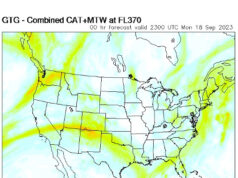
While the terms in this title sound like they’re right out of a gridiron playbook, they are not. Rather, the terms are used to describe the path of a low pressure center in coastal winter storm scenarios. If you live on the Eastern Seaboard (particularly New England), this may be particularly pertinent. If you live in California, you can enjoy the laugh but learn what it could mean to you traveling into the east.
These two terms refer to where a low pressure system tracks in relation to a specific point, the “40/70 Benchmark” which is 40°N latitude and 70°W longitude east of central New Jersey). The proximity of a low pressure system to this point can impact weather implications.
It’s in the AFD.
As pilots, we may never hear any of these terms mentioned in our tailored and approved aviation weather forecasts. These terms however are most frequently referenced by National Weather Service (NWS) forecasters when they are writing their “Area Forecast Discussion” or AFD. The AFD is a clickable link found at weather.gov. Look for “Forecast Discussion” at the bottom of the page for a specific area forecast. The Forecast Discussion provides the reasoning supported by the quantitative weather forecast, or more simply, what the forecasters think is going to happen. Inside runner and/or outside runner are not used in aviation weather products, but you’ll find them in the AFD.
When coastal storms are the discussion, “inside” and “outside” runners address a low pressure system’s track in relation to the 40/70 Benchmark. Which term is used to describe the storm can be a determinant in how much rain, snow and wind (to name a few weather hazards) you may experience at a particular place.
Inside or Outside?
If you like snow, you’ll want the low pressure to track right over the 40/70 Benchmark or only slightly southeast (i.e. outside runner). This particular track over or just outside the Benchmark favors a colder scenario. This is because the winds favor a more northerly component and therefore will have less of an Atlantic Ocean “fetch” of warmer ocean air. You may also hear this sort of storm referred to as “cold sectored.”
If you’re like me and despise snow, you will prefer a track northwest of the 40/70 Benchmark (i.e. Inside Runner). This track favors a warmer scenario as the predominate winds will be more easterly and therefore have more of an Atlantic Ocean “fetch.” The Atlantic Ocean is warm compared to the air mass during the winter. You can expect this sort of storm to be referred to as more “warm sectored.”
One last factor to consider is the size of the low pressure center. A smaller sized low, and it’s associated track with reference to the 40/70, will be more critical than a larger low pressure center.
To summarize
While this article deals with nomenclature to which pilots are not normally exposed, the relevance is certainly obvious.
As coastal low pressure systems gain attention, particularly in winter, the NWS forecasters will be very interested in exactly where the low pressure tracks in relation to the 40/70 Benchmark. As the situation unfolds, you can read frequent updates to the AFD and see where the NWS forecasters feel the low will actually track.
As the low moves, the forecast has the potential to be anywhere from a “fish storm” (meaning well southeast of the 40/70 Benchmark and therefor not impacting land) to a real heavy hitter (tracking right over the 40/70). What you’re rooting for is up to you. I say, “Give it to the fish.”
To be clear, the track of a low pressure system does not correlate directly to its strength, but rather what population experiences what effects. Sometimes, these storms can be pretty potent, so it follows that potency of a low pressure center means nothing (except to shipping) if it blows out to sea. But to be clear, strength and track are technically two different factors within a storm scenario.
I believe knowledge is power and the better informed we are, the safer we can be. These terms provide information which, of course, can provide favorably for the safety picture. Earlier, I referenced football. In a way, keeping tabs on low pressure tracks with respect to the 40/70 Benchmark is a bit like watching a game. Watch the game (weather system) closely enough, understand it well so that you would make John Madden proud.






















































